The 2023 Toyota GR Corolla Is Unrefined in All the Right Ways
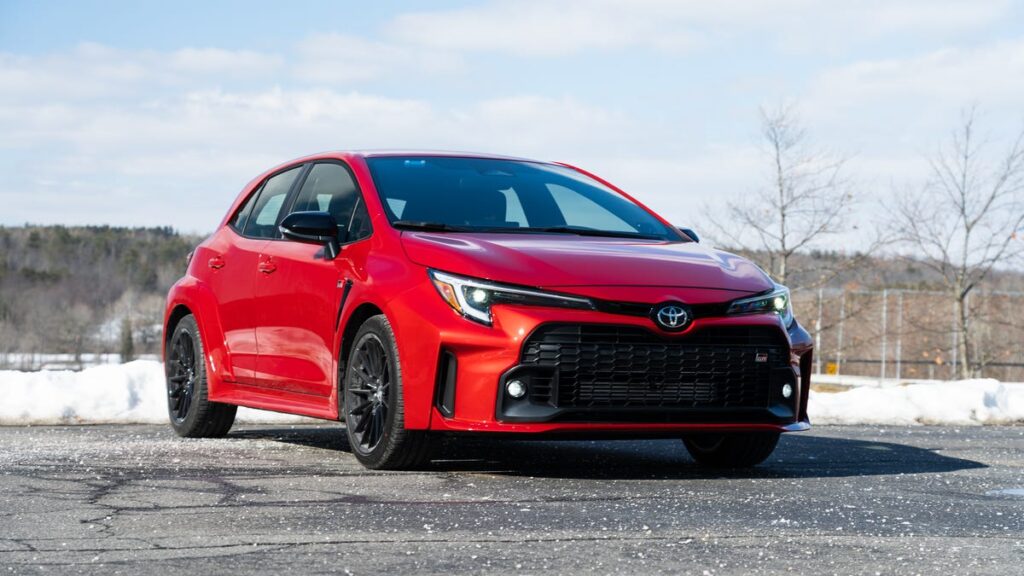
This isn’t a car. What you’re looking at is a 300-hp, all-wheel-drive recipe for hooliganism. The only time I wasn’t driving this car to its absolute limit was when I tested its cargo capacity by making a run to the grocery store. Yet even with a trunk full of bruise-happy Honeycrisps I couldn’t keep from toggling into Sport mode on the way home.
As Adam Ismail found out on Jalopnik’s initial drive of this car last year, the GR Corolla is superb when driven hard. But how is it when it comes to daily-driving? And how well does it live up to the standards set by its homologated predecessors like the GD Subaru WRX STI and Celica GT-Four? That’s what I aimed to find out.
Hardware
Photo: Tim Stevens / Jalopnik
Let’s start with a deeper look at the numbers, because they are quite something. The Toyota GR Corolla makes 300 hp and 273 lb-ft of torque, figures that become absolutely remarkable when you realize where they come from: a 1.6-liter inline three-cylinder. Yes, just three wee pistons propel this car from 0 to 60 in a manufacturer-claimed 4.99 seconds.
That is wild. That the car only weighs 3,252 pounds helps, but it should come as absolutely no surprise that a little motor putting out big numbers like that must have some help, and here it comes from a heady 26.3 psi of boost, a figure that takes some time to build. More on that in a moment.
G/O Media may get a commission

up to 80% off
Refurbished Chromebook Sale
Super Chromebook savings
Choose from two refurbished options, available at StackSocial. The Dell Chromebook 5190 11-inch Touchscreen 1.1GHz 4GB RAM 16GB eMMC is just $80, down from $289, which is 72% off. Or you can pick up the Acer N7 C731 Chromebook 11-inch 1.6GHz, 4GB RAM 16GB eMMC, which is $57, down from its usual price of $289. That’s a savings of 80%.
That engine is connected to the wheels through a small, lightweight, but remarkably effective all-wheel-drive system. Don’t tick any boxes when ordering a GR Corolla Core and you’ll get open differentials front and rear, which in my book would be a bit of a shame, since it’s only $1,180 to get Torsen LSDs at both the front and the back.
The magic, though, is in the center differential — or, to be specific, the lack thereof. Instead of a traditional center diff to divide the power front-to-rear, there’s a wet clutch pack that varies torque distribution between the two axles.
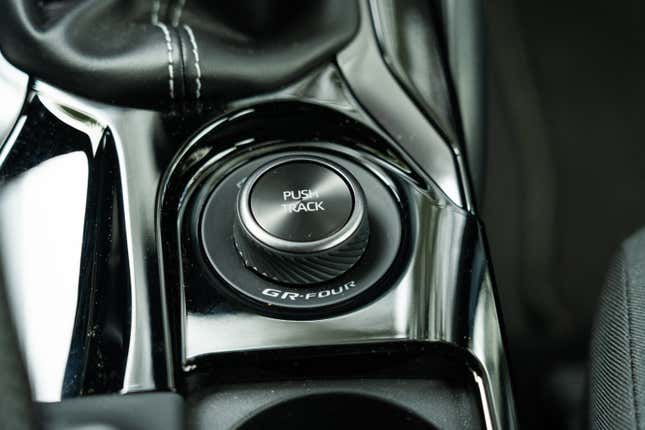
Photo: Tim Stevens / Jalopnik
It’s controlled through a big, chunky knob labeled “GR-Four” — harkening back to the Celica GT-Four homologation special days of yore. (Fun fact: the hottest Celica GT-Four, the ST205, made 252 hp and weighed 3,064 pounds. Yes, that’s 200 fewer lbs than the GR Corolla, but it had 48 fewer ponies, too, and a whopping eight fewer airbags.)
Twist that knob to the left and you get a 60/40 torque split with the majority of power going to the front axle. This is an ideal setup for day-to-day aggressive driving, especially in low-grip situations — the sort that I had hoped to run this car through on a frozen lake during my loan, but yet another too-warm winter ruined those chances.
Twist the knob to the right and you get a 30/70 split, now with the majority of the power hitting the rear wheels under normal conditions. This is a better configuration when you have more grip at your disposal, dry asphalt and the like. This delivers a playful, rear-biased feel.
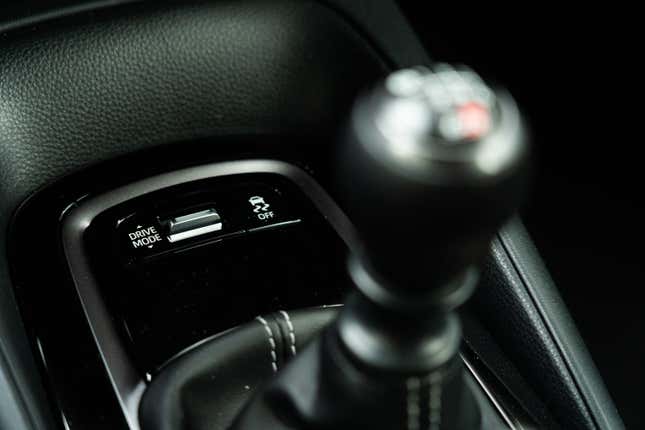
Photo: Tim Stevens / Jalopnik
Finally, you can push the knob down to engage Track Mode, which does its best to divide the power equally between both axles.
These modes are separate from the car’s traction-control and engine settings, toggled via a rocker switch just ahead of the six-speed shifter. Yes, it’s manual, with three pedals, and it’ll even rev-match for you if you like.
Toggling from Eco to Normal up to Sport really just makes the car louder and the throttle sharper, but at the end of the day it’s always on its toes, always ready to play.
Play time
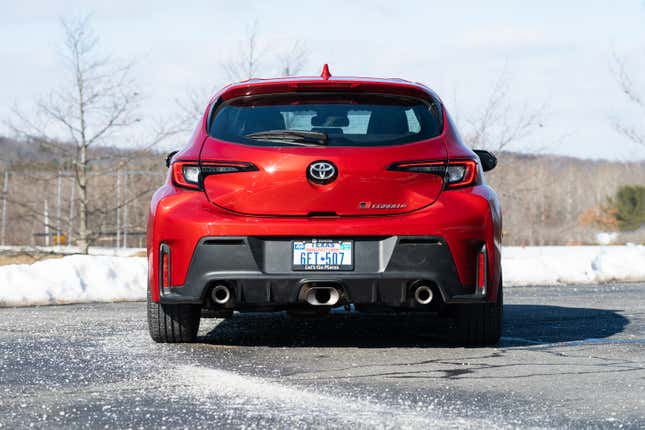
Photo: Tim Stevens / Jalopnik
One foot on the brake, another on the short but firm clutch, then stab at the GR Start/Stop button. That little three-pot fires to life with, not exactly a roar but definitely an aggressive, bassy note. Triples have never been common, especially in sporty applications like this, and so it should come as no surprise that the GR Corolla sounds unusual.
It sounds nothing like my turbocharged 1991 Toyota MR2, which shares a motor with the Celica GT-Four. In fact, it sounds much more like my 2005 Triumph Speed Triple, which as you can probably guess from the name also offers an odd number of cylinders.
For a stock exhaust system, the GR Corolla is loud. You’ll hear it coming. Inside the cabin, the mechanical nature of the engine pairs nicely with the boominess of the exhaust. Get on the throttle hard and it really does make for a good soundtrack. Lift off quickly, listen closely, and there’s just a hint of wastegate flutter there — not so sweet as the chirping Corollas of WRC yore, but enough to put a smile on your face. Importantly, there’s none of the annoying, off-throttle overrun that plagues the Honda Civic Si.
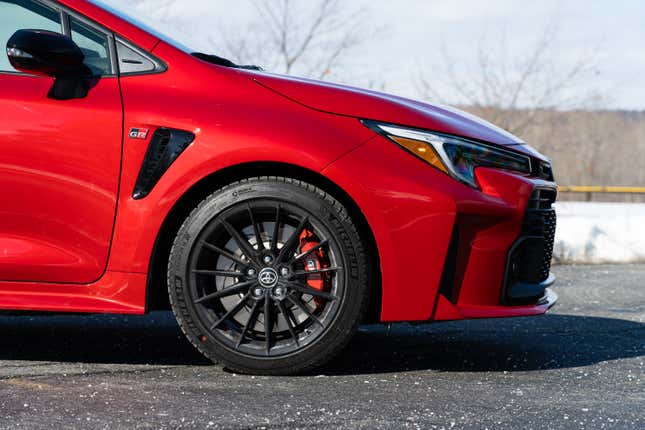
Photo: Tim Stevens / Jalopnik
That said, getting off-throttle is not something you will want to do lightly, because that will mean having to build boost again. Yes, there’s turbo lag here, lots of it by modern standards. The GR Corolla has better throttle response than my turbo’d MR2 but worse than my 2004 Subaru STI. It is quite noticeable and, at first, annoying.
In time, it becomes part of the character of this car. Charm, even. You need to plan a little ahead, get on that throttle a moment before you hit the apex, and you’re rewarded with a great surge of torque and sound to send you squealing through to the next.
The steering on the GR Corolla is direct by modern standards, with reasonably good feedback. Resistance is variable and, set to the lowest, you can wheel this thing aggressively like a rally car without toning your forearms.
The shifter on the other hand can require a bit of muscle, and a bit of patience, too. The feel isn’t exactly world-class and the gearing, too, seems just a bit too tall. This is probably the biggest place where the car doesn’t feel like a homologation special of yore. In my 2004 STI, the first four gears are manic and short, 4,250 rpm at 60 in 4th. The GR Corolla, on the other hand, feels a little more lazy, turning over at 3,750 in 4th. Both have 7,000-rpm redlines.
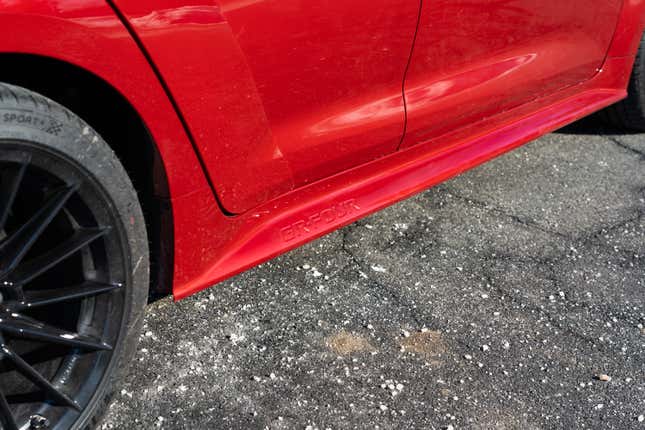
Photo: Tim Stevens / Jalopnik
When it’s time to slow down again, drilled metal pedals are nicely positioned for toe-heeling if you’re feeling fancy, though the aforementioned auto-blip system does a fine job.
I did most of my testing in near-freezing temperatures on summer tires, so even though I couldn’t get this Corolla on ice like I’d wanted to, I still had plenty of situations where grip was at a premium. Helping that was a set of Michelin Pilot Sport 4 tires, each doing its best to hang on despite ambient temperatures on the lower end of ideal. The Corolla stayed poised and in control at all times, any slips easily caught and corrected. The grins, though, were harder to get rid of.
The suspension on the GR Corolla is slightly over-firm, which means it dances around and feels absolutely alive beneath you when you’re hustling down an uneven country lane. That feeling, plus the quick steering, create a car that wants to be driven hard. But of course, sometimes we just need to get from A to B.
Cruising
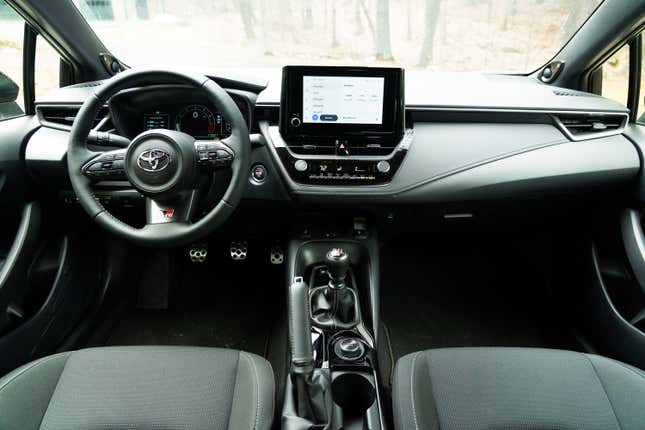
Photo: Tim Stevens / Jalopnik
What’s the GR Corolla like to drive when you’re just commuting? Well, in Eco mode the throttle is relaxed enough that you won’t have to worry about launching through stoplights, but the lack of adaptive dampers brings a perpetual harshness to the experience.
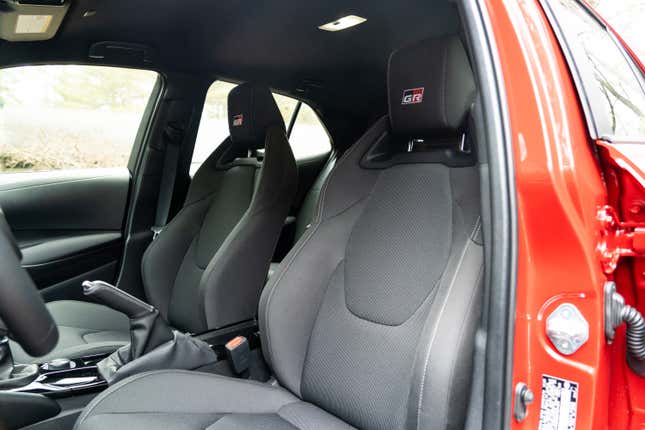
Photo: Tim Stevens / Jalopnik
If you’re picking up someone with a sensitive disposition, you’d best prep your apologies early. The smoothest of roads will test the patience of your passengers as they’re jostled around in the otherwise quite comfortable, supportive seats. The GR is simply not able to morph into a calm shuttle the way the latest Civic Type R can.
Bumpiness aside, seating for four or even five is feasible despite the Corolla’s diminutive dimensions. There’s plenty of headroom throughout, though legroom in the back is tight.
To challenge the Corolla’s 17.8 cubic feet of cargo space, I made the obligatory Whole Foods run. That hatch swallowed up a generous order without issue. There’s even a hidden bit of cargo space under the rear floor if you don’t mind stuffing your condiments around the rear-mounted battery.
Wireless charging plus an extra USB-C port to the side provides plenty of juice up front, but passengers in the back will have to fight over a single USB-C positioned between the front seats. Don’t fret: They’ll probably be too car-sick to want to look at their phones.
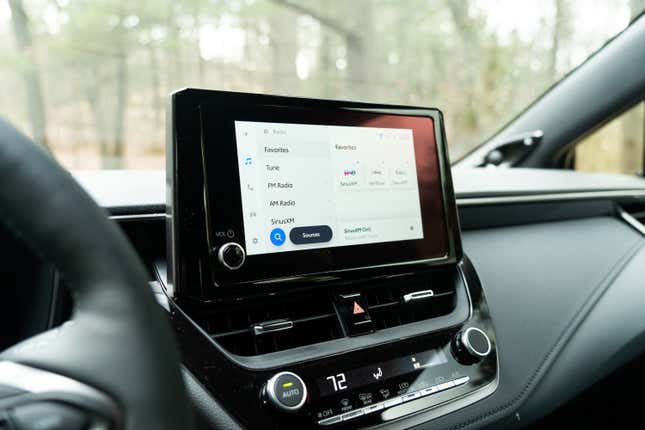
Photo: Tim Stevens / Jalopnik
Toyota’s infotainment system is visually basic to the extreme but it’s got it where it counts, with snappy performance and voice recognition that, while a bit slow to respond, never missed a beat, even when I asked it to take me to Schenectady.
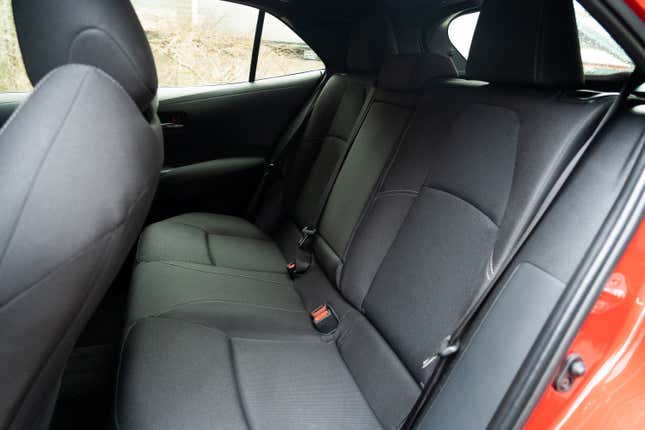
Photo: Tim Stevens / Jalopnik
That pairs nicely with the 12.3-inch virtual gauge cluster behind the steering wheel. This is divided into three sections. On the left you can toggle between a comprehensive set of gauges including coolant temperature, oil temperature, and oil pressure. Other choices there include a boost gauge and tire pressure readout.
On the right there’s the typical nav and trip stuff, but the G meter is much more fun. Meanwhile, front and center is the big, sweeping tachometer, plus a little readout to tell you which differential mode you’re in. It’s all simply presented but useful information, exactly the details I’d want for a day at the track.
Finally, there’s the exterior styling of the thing, which I adore. The chunky fenders are punctuated by vents that are functional, and though the rear diffuser may not be, the overall look is fantastic. I was already a big fan of the way the base Corolla hatchback looked. This just amps it up another notch.
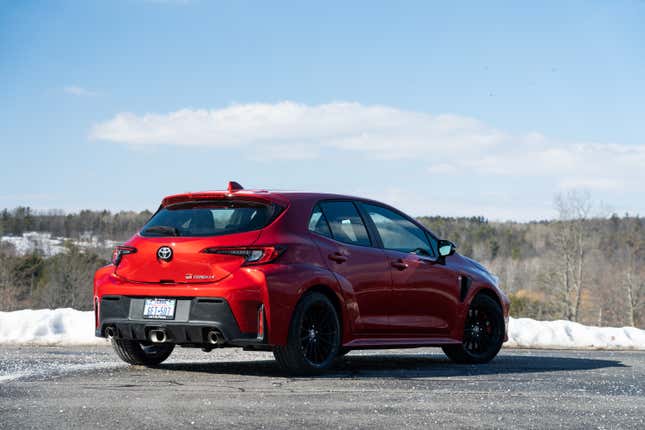
Photo: Tim Stevens / Jalopnik
My only real complaint is the color selection. The so-called Supersonic Red you see here looks clean enough, but the fact that it’s so often seen on Camrys and RAV4s takes away some of the charm. Your other choices? Black or white. Ho and hum.
On the inside, it’s a sea of monotone plastics and fabrics with clashing fake-leather textures. Only a few faux metal highlights around the vents try to brighten things up. It is dark and dour and it’s totally fine because it all feels durable, and it’s abundantly clear that Toyota didn’t waste any money on the unimportant stuff.
Wrap-up
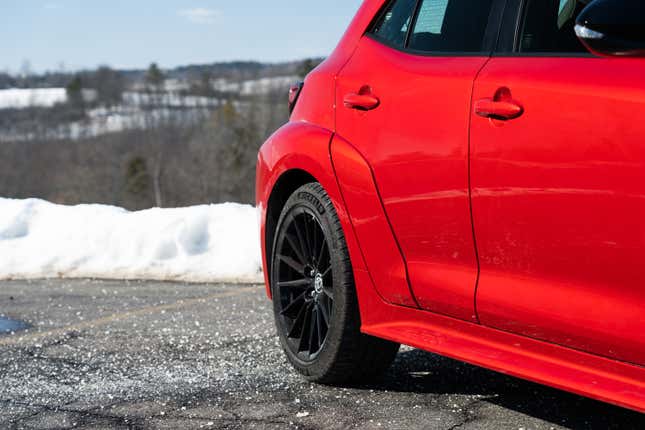
Photo: Tim Stevens / Jalopnik
I absolutely fell in love with the GR Corolla. It’s not for everyone, and it’s important you realize that it will not be pleasant for any but the most stoic of passengers. This, though, is a car that made me grin and giggle like nothing else. It’s fast enough to impress but still slow enough that you can really flog it without being a risk to society. It’s a lot like the GR 86 in that way, and I think Toyota deserves a lot of credit for now having not one, but two of the best affordable sports cars on the market.
Most importantly, it offers the rowdy, unrefined feel that made all those ‘90s and 2000s homologation specials great. It has all the charm of my 2004 STI but with more modern dynamics and, perhaps most importantly, modern safety features. Here in the U.S., we missed out on so many limited editions back in the day that it’s hard not to feel thankful for this one — even if your car-pool crew may cringe when your day comes up on the rotation.



